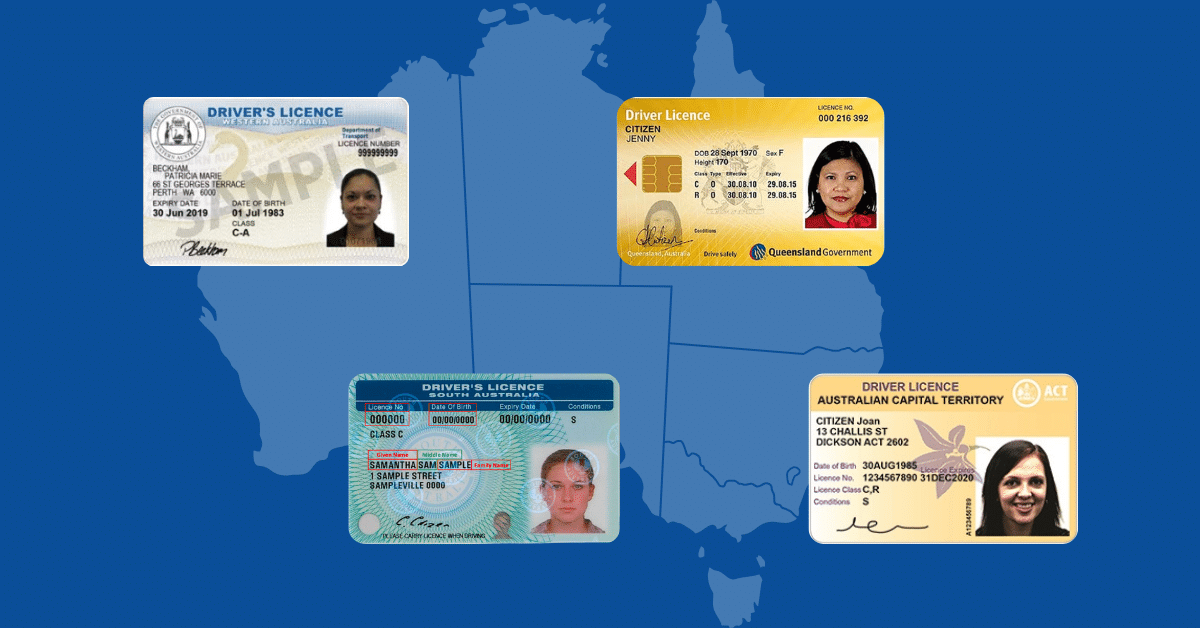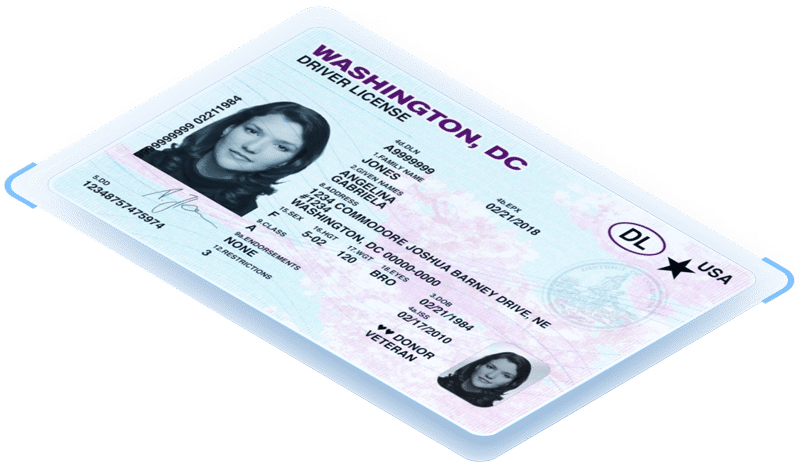Last updated on July 8th, 2025 at 07:49 am
Verifying an Australian driver’s license (driver licence) is an essential step for businesses that need to confirm identity for onboarding customers, preventing ID fraud, or ensuring regulatory compliance. But with each Australian state or territory issuing different licenses, understanding how to properly authenticate these IDs can be complex.
Physical Australian license features & data
Each Australian state and territory issues its own design. While layouts and security features vary slightly, all Australian licenses contain:
- Full name
- Date of birth
- Photo
- Address
- License number
- Expiry date
- Issuing state or territory
- A unique licence card number
Australian drivers license security features
Most Australian licenses contain additional security features that aren’t always obvious upon visual inspection. Because layouts vary, it is essential to use ID authentication software that recognizes the templates for each jurisdiction. Many licenses contain security features, such as:
- Holographic elements
- Microprint security text
- UV features
- Ghost images (faded secondary photos)
- Windowpane elements
Authentication hardware, combined with ID verification software, is capable of ensuring all of the correct security features are present and correct for the template.
Australian driver license barcodes
Unlike US government-issued IDs, Australian IDs don’t have PDF417 barcodes. This can make verification more difficult, as some ID scanning tools rely heavily on reading PDF417 barcodes for age and expiration status verification and document verification. PDF417 barcodes are the standard data storage symbology for US IDs because they are capable of containing all of the information printed on the front of the ID, as well as specific formatting that can indicated legitimacy. It is essential that companies verifying Australian IDs use an authentication solution capable of verifying documents without the use of PDF417 barcode scanning.
Some Australian IDs have 1D barcodes that can be scanned, which typically contain very basic information such as ID number and state or territory code.
In lieu of more advanced barcodes, some Australian drivers licenses have data stored in a magnetic stripe (magstripe). Magstripes cannot be scanned, but can be swiped in compatible ID scanners to read and verify the data.
Differences between North American and Australian drivers licenses
The primary difference between North American and Australian IDs is that both Canada and the US follow national design standards, while in Australia, each state sets its own. This means that Australian ID formats can vary much more widely between states.
US ID standards are set by the American Association of Motor Vehicle Administrators (AAMVA) and Canadian ID standards are set by the Canadian Council of Motor Transportation Administrators (CCMTA). Several Canadian jurisdictions are also members of AAMVA. Adhering to set standards for IDs throughout the country makes reading and authenticating IDs more straightforward, as one piece of hardware will be able to verify all IDs, and makes the IDs more secure as they are required to include many security features designed to deter ID fraud.
A key security feature included in AAMVA’s guidelines is the PDF417 barcode, which stores personal data in a uniform way to ensure IDs issued by different states can be read and interpreted consistently. Other AAMVA guidelines include:
- Mandatory data elements: first and last name, date of birth, date of issue, expiration date, ID number, photo, signature, address, sex, height, weight, eye color, vehicle classifications, endorsements, restrictions, issuing jurisdiction, organ donor status, and veteran indicator
- Placement guidelines for data elements
- A specified minimum set of mandatory security features and a list of optional security features
- Mandatory security features include no CMYK colors and at least two special colors, a guilloche design, UV fluorescent ink, dynamic data elements, laminate overlay, and a security background overlapping the image area.
Australian drivers licenses by state and territory
Most current Australian IDs have a similar style, with the document type (drivers license, ID card, learner’s permit) and state printed at the top, the photo on the right side with a white background, and the cardholder’s signature. However, there are a few outliers even from this mostly standard format.
Australian Capital Territory drivers license features

Key Australian Capital Territory ID features:
- Similar template to most Australian IDs
- ID holder’s signature security feature
- Image of the bluebell flower, the floral emblem of the Australian Capital Territory
- Date format: day, month abbreviation in all capital letters, and year without any spaces (ex. 08AUG1994)
The Australian Capital Territory ID does not include a magstripe or barcode, so it can only be scanned with an OCR-capable ID reader. The Australian Capital Territory ID also does not feature a ghost photo or windowpane feature.
New South Wales drivers license features

Key New South Wales drivers license features:
- Ghost photo security feature on the front
- Image of the waratah flower, the floral emblem of NSW
- Card number and license number
- Magstripe with ID data
- Option for mobile drivers license (mDL), available through the Service NSW app
- Date format: date, month abbreviation in all capital letters, and year, all with spaces in between (ex. 04 AUG 1994)
Because the New South Wales ID does not have a barcode, an ID scanner such as the E-Seek M260 with magstripe reading capability must be used to read the ID data.
Northern Territory drivers license features

Key Northern Territory drivers license features:
- Different general layout from most Australian drivers licenses, features the primary ID photo on the left side as opposed to the right
- Smaller cardholder photo on the right side with security feature overlays
- Microprint patterns
- Image of the state flower, the desert rose
- Date format: DD/MM/YYYY
The Northern Territory ID does not include a magstripe or barcode, so it can only be scanned with an OCR-capable ID reader. The Northern Territory ID also does not feature a ghost photo or windowpane feature.
Queensland drivers license features

Key Queensland drivers license features:
- Ghost photo
- RFID chip
- Date format: format is featured two different ways, DD.MM.YYYY (ex. 04.08.1994) for the effective and expiry date, and day, month abbreviation, full year, with spaces in between, for the birth date (ex. 04 Aug 1994)
On newer versions of the Queensland ID the chip is not visible, it is still present and offers a way to securely verify the document’s authenticity. The Queensland ID does not include a magnetic strip or barcode, so only an ID reader capable of OCR and RFID reading can authenticate these documents.
South Australia drivers license features

Key South Australian drivers license features
- Hologram of the state’s crest repeated several times
- Ghost photo
- Magnetic stripe, which stores ID data
- Option for mobile drivers license (mDL), available through the mySA GOV app
- Date format: DD/MM/YYYY
The magnetic strip on the South Australian drivers license can be read with a compatible ID scanner, such as the E-Seek M260.
Tasmania drivers license features

Tasmanian ID key features:
- Rectangular windowpane section
- Raised numbers on the ID photo
- 1D barcode on the back, but no other more advanced barcode or magstripe
- Hologram map of Tasmania
- Date format: date, month abbreviation in all capital letters, and year, all with spaces in between (ex. 04 AUG 1994)
Tasmanian ID does not include a magstripe or 2D barcode, so it can only be scanned with an OCR-capable ID reader.
Victoria drivers license features

Australia’s Victoria ID key features:
- Rectangular windowpane section
- Raised numbers on the ID photo
- 1D barcode on the back, but no other more advanced barcode or magstripe
- References “Vic Roads.” VicRoads is the primary body responsible for driver’s licenses, learner permits, and other related services in Victoria
- Option for mobile drivers license (mDL), available through the Service Victoria app
- Date format: DD-MM-YYYY
Because the Victoria ID does not include a magstripe or 2D barcode, it can only be scanned with an OCR-capable ID reader.
Western Australia drivers license features

Western Australian ID key features:
- No ghost photo, but portrait photo edges fade out as opposed to a typical rectangle
- This security feature can make creating fake Western Australian IDs more difficult for less sophisticated criminals
- Date format: day, month abbreviation, full year, with spaces in between, for the birth date (ex. 04 Aug 1994)
- Features a black sawn, the state’s emblem
- Rainbow laminate that shifts under white light
- 1D barcode on the back, but no other more advanced barcode or magstripe
Because the Western Australia ID does not include a magstripe or 2D barcode, it can only be scanned with an OCR-capable ID reader.
Why verify Australian drivers licenses?
Driver’s licenses are the most commonly used form of photo ID in Australia. They are regularly used for age verification for alcohol and gambling, identity verification for financial services, access control for secure environments, and customer onboarding.
Due to the breadth of uses, fake or altered IDs are frequently used by fraudsters and criminals. Verifying an Australian license ensures that the individual is who they claim to be and that the document itself is genuine.




